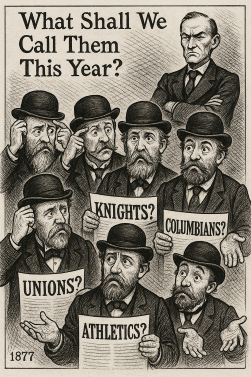The Federal League: 1877
The Federal League entered its second season with fewer clubs but no less controversy. The expulsions of St. Louis and Cincinnati had stunned some observers, yet Charles W. Garrison made no apologies. “Better six strong than eight weak,” he reportedly quipped, and the league proceeded into 1877 with a half-dozen survivors.
A Shuffle of Names
 The season also opened under a haze of confusion. Newspapers and cranks insisted on rechristening the clubs, and the league did little to resist. The Philadelphia Centennials were now the Unions, while the Brooklyn Unions curiously styled themselves the Athletics. In New York, the Knights took up the mantle of the Columbians, and Boston’s Pilgrims staggered forward as the Resolutes. Garrison bristled at the chaos, but even he recognized that public fancy could not be legislated from a rulebook. “The cranks will call them what they wish,” he sighed, “and the papers will print it.”
The season also opened under a haze of confusion. Newspapers and cranks insisted on rechristening the clubs, and the league did little to resist. The Philadelphia Centennials were now the Unions, while the Brooklyn Unions curiously styled themselves the Athletics. In New York, the Knights took up the mantle of the Columbians, and Boston’s Pilgrims staggered forward as the Resolutes. Garrison bristled at the chaos, but even he recognized that public fancy could not be legislated from a rulebook. “The cranks will call them what they wish,” he sighed, “and the papers will print it.”
On the Field
Whatever the name, the race was fierce. The New York Columbians and Chicago Base Ball Club finished within half a game of one another, New York barely seizing the pennant with a 40–21 mark. Chicago’s Harry Taylor was brilliant again, leading the league in earned run average at 2.02, but the Columbians’ balance proved decisive.
The keystone position remained the sport’s glamour post. Charlie Morris, second baseman for New York, captured the batting title at .352, with his teammate Patrick “Factotum” Manke close behind at .345. Manke’s offseason jump from Philadelphia to New York was still being muttered about in taverns from Chestnut Street to Broadway, but no one doubted his ability to transform a club. Behind the plate, Chicago’s stalwart catcher Hoss Metcalf hit .327, further proof that offense could be found where most expected only bruises.
On the slab, the laurels were shared. Taylor’s stingy ERA kept Chicago alive, but the wins crown went to Sam Coleman of Brooklyn, who shouldered a staggering load to record 35 of his club’s 36 victories. In New York, the Irish-born Gus Murphy (14–8, 2.22) paired with 23-year-old newcomer Harlan Beesley (26–13, 2.11), giving the Columbians a one-two punch unmatched in the league.
Final Standings, 1877
| Team | W | L | WPct | GB | R | RA |
|---|---|---|---|---|---|---|
| New York Columbians | 40 | 21 | .656 | — | 371 | 257 |
| Chicago Base Ball Club | 38 | 20 | .655 | ½ | 370 | 262 |
| Brooklyn Athletics | 36 | 24 | .600 | 3½ | 278 | 233 |
| Philadelphia Unions | 27 | 33 | .450 | 12½ | 263 | 298 |
| Detroit Woodwards | 23 | 37 | .383 | 16½ | 306 | 388 |
| Boston Resolutes | 16 | 45 | .262 | 24 | 298 | 448 |
A League in Transition
Though the Columbians claimed the flag, Garrison claimed the real victory. The Federal League had survived its first test of authority, stabilized its membership, and proven it could stage a championship season unmarred by desertion or scandal. Still, with attendance uneven and clubs constantly tinkering with their identities, it was plain that the experiment was far from secure.
For now, the cranks of New York cheered their champions, Chicago cursed their half-game fate, and the rest of the league trudged on, learning that in the Federal League, survival itself was an achievement.